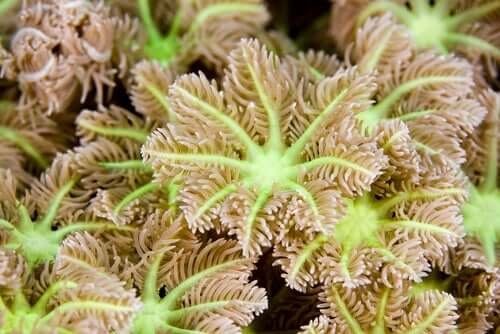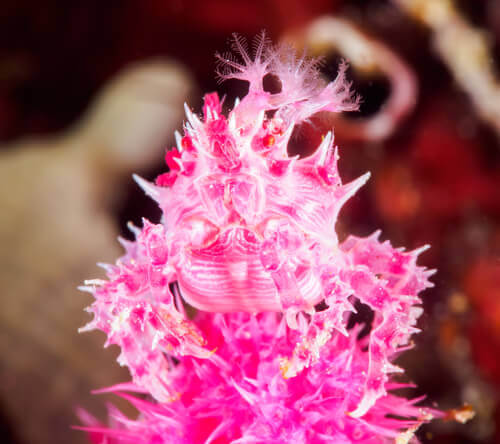Natural Wonders: What Are Soft Corals?


Written and verified by the biologist Paloma de los Milagros
Soft corals are a type of Cnidaria which stand out for their lack of an internal calcium carbonate skeleton. They form some of those gorgeously colorful coral reefs you’ve probably seen in pictures, especially in tropical areas.
These marine invertebrates belong to the Alcyonacea order, which has two major groups. First, there are true soft corals, and then there are gorgonians, or sea fans. The second kind has a central axis, which is why it waves around like a fan.
Unlike hard corals, true soft corals have a skeleton-like feature called sclerites. These calcified structures give them some support and rigidity, along with a spiny texture that acts as a form of self-defense.
A lot of these invertebrates, except for some gorgonians, don’t do photosynthesis, and they don’t have a symbiotic relationship with zooxanthellae. Instead, they have eight or more tentacles in the shape of a fan, or a whip, that help them capture nutrients.
What are soft corals?
Soft corals are basically colonies of small, connected polyps, which come in lots of different shapes. Some of them might have two kinds of polyps, with long autozooids and tentacles, and short syphonozoids that filter water. When they’re all together in a long line, they can create gorgeous coral reefs in colors like red, purple, and yellow.
There are lots of gorgonians in the Caribbean Sea, and more soft corals in the Pacific Ocean. That’s where you’re most likely to see them, but they’re actually all over the world. For example, there are the macabrely-named species “dead man’s fingers” (Alcyonium digitatum), which is common along the Norwegian coast.

Most soft corals get their nutrition by feeding on plankton or small suspended particles. To do that, each polyp uses a process called filter feeding. They move their tentacles around to create currents, and use the “thorns” on their tentacles to capture their food.
The spread and conservation of soft corals
They’re extremely versatile in terms of reproduction. Oddly enough, they can reproduce both sexually and asexually. In the first case, the polyps create eggs or sperm, which form independent larvae when they come together.
Once they develop, they begin their life in the colony. Some of these kinds of coral are hermaphrodites, either the simultaneous or sequential kind. Sequential hermaphrodites produce both male and female gametes, just not at the same time.
There are a few different ways asexual reproduction can happen:
- Fragmentation: this is extremely common with soft corals. It basically takes place if one section randomly breaks off. But it will only be able to develop a colony once it splits off if it already has eight or more polyps.
- Budding: this takes place when a bud or shoot from the parent coral creates a new polyp. That new polyp will have all the tentacles and other structures it needs to swim and be independent.
- Division: this can be either longitudinal or transverse, depending on the structure of the polyp. It can also happen that a polyp secretes a new basal plate, which is basically the part of it that allows it to stick to the colony.

Threats to soft coral
Like the other kinds of coral, soft corals provide shelter for fish, seahorses, and other small marine species. But there’s also a risk of large animals eating them, and some have adapted to emit chemicals as self-defense. Some of these substances have properties that are a major part of the modern pharmaceutical industry.
The biggest threat to soft corals right now is the loss of their habitat. They’re the main goal of a lot of eco-tourists, and this has led to a huge decline in their population.
There are also a lot of illegal practices that involve selling them on the black market. We really need to change our behavior and write laws to protect them if we want them to keep making these gorgeous, colorful coral reefs long into the future.
Soft corals are a type of Cnidaria which stand out for their lack of an internal calcium carbonate skeleton. They form some of those gorgeously colorful coral reefs you’ve probably seen in pictures, especially in tropical areas.
These marine invertebrates belong to the Alcyonacea order, which has two major groups. First, there are true soft corals, and then there are gorgonians, or sea fans. The second kind has a central axis, which is why it waves around like a fan.
Unlike hard corals, true soft corals have a skeleton-like feature called sclerites. These calcified structures give them some support and rigidity, along with a spiny texture that acts as a form of self-defense.
A lot of these invertebrates, except for some gorgonians, don’t do photosynthesis, and they don’t have a symbiotic relationship with zooxanthellae. Instead, they have eight or more tentacles in the shape of a fan, or a whip, that help them capture nutrients.
What are soft corals?
Soft corals are basically colonies of small, connected polyps, which come in lots of different shapes. Some of them might have two kinds of polyps, with long autozooids and tentacles, and short syphonozoids that filter water. When they’re all together in a long line, they can create gorgeous coral reefs in colors like red, purple, and yellow.
There are lots of gorgonians in the Caribbean Sea, and more soft corals in the Pacific Ocean. That’s where you’re most likely to see them, but they’re actually all over the world. For example, there are the macabrely-named species “dead man’s fingers” (Alcyonium digitatum), which is common along the Norwegian coast.

Most soft corals get their nutrition by feeding on plankton or small suspended particles. To do that, each polyp uses a process called filter feeding. They move their tentacles around to create currents, and use the “thorns” on their tentacles to capture their food.
The spread and conservation of soft corals
They’re extremely versatile in terms of reproduction. Oddly enough, they can reproduce both sexually and asexually. In the first case, the polyps create eggs or sperm, which form independent larvae when they come together.
Once they develop, they begin their life in the colony. Some of these kinds of coral are hermaphrodites, either the simultaneous or sequential kind. Sequential hermaphrodites produce both male and female gametes, just not at the same time.
There are a few different ways asexual reproduction can happen:
- Fragmentation: this is extremely common with soft corals. It basically takes place if one section randomly breaks off. But it will only be able to develop a colony once it splits off if it already has eight or more polyps.
- Budding: this takes place when a bud or shoot from the parent coral creates a new polyp. That new polyp will have all the tentacles and other structures it needs to swim and be independent.
- Division: this can be either longitudinal or transverse, depending on the structure of the polyp. It can also happen that a polyp secretes a new basal plate, which is basically the part of it that allows it to stick to the colony.

Threats to soft coral
Like the other kinds of coral, soft corals provide shelter for fish, seahorses, and other small marine species. But there’s also a risk of large animals eating them, and some have adapted to emit chemicals as self-defense. Some of these substances have properties that are a major part of the modern pharmaceutical industry.
The biggest threat to soft corals right now is the loss of their habitat. They’re the main goal of a lot of eco-tourists, and this has led to a huge decline in their population.
There are also a lot of illegal practices that involve selling them on the black market. We really need to change our behavior and write laws to protect them if we want them to keep making these gorgeous, colorful coral reefs long into the future.
All cited sources were thoroughly reviewed by our team to ensure their quality, reliability, currency, and validity. The bibliography of this article was considered reliable and of academic or scientific accuracy.
- Bruckner, A. (2013). Khaled bin Sultan Living Oceans Foundation. Corals Without Skeleton. Recuperado de https://www.livingoceansfoundation.org/corals-without-skeletons/
- LaGuíaDelAcuario. (2017). Reproducción asexual de los corales marinos. Recuperado de https://laguiadelacuario.com/reproduccion-asexual-de-corales-marinos/#Reproduccion_asexual_de_corales_marinos
- Resorts World Sentosa. (2017). S.E.A. Aquarium Hard Corals vs Soft Coral. Recuperado de http://seaa.rwsentosablog.com/hard-corals-soft-corals/
- WildFactSheets. (2016). Soft corals. Recuperado de http://www.wildsingapore.com/wildfacts/cnidaria/coralsoft/coralsoft.htm
This text is provided for informational purposes only and does not replace consultation with a professional. If in doubt, consult your specialist.







